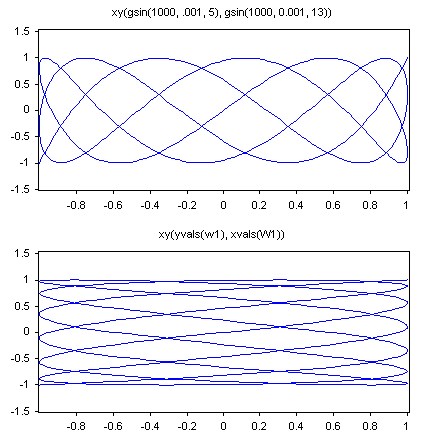
DADiSP Online Help
Click here to see this page in full context

Creates an XY series.
XY(xseries, yseries)
|
xseries |
- |
Series to be used as X values. |
|
yseries |
- |
Series to be used as Y values. |
An XY series.
W1: xy(gsin(1000, .001, 5), gsin(1000, 0.001, 13))
W2: xy(yvals(w1), xvals(W1))

W1 contains an XY graph where the X and Y values are obtained form the sine function. W2 exchanges the axes.
XY creates series where the X values are not regularly spaced. However, many series have X values that are monotonically rising by a constant X increment such that:

A series with X values of this form is referred to as an interval series. Because any X value from an interval series can be computed with:

an interval series requires only the DELTAX and XOFFSET values to determine the X values. Thus, for an interval series, explicit X values are not necessary, decreasing the data storage requirements by a factor of 2. Also, because the X values for an interval series are regularly monotonic, speed optimizations for plotting and computations are available.
Consider the following:
t = 3..10;
y1 = xy(t, t^3);
y2 = t^3;
The series y1 is an XY series where the X values are explicit. The series contains a total of 16 samples, 8 X samples and 8 Y samples.
The series y2 is an interval series where the delta X value is 1 and the X offset is 3. Both series plot with the same X values, but the X values for y2 are computed on the fly, decreasing the storage requirements to 8 samples total.
Use XYINTERP to convert an XY series into an interval series for optimized processing by standard series operations.
See XYALT to create an XY plot with alternate scales.
See XYDT to create an XY series with date and time series.